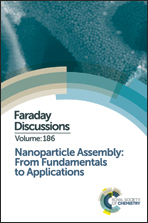Interplay between polymer chain conformation and nanoparticle assembly in model industrial silica/rubber nanocomposites
Abstract
The question of the influence of nanoparticles (NPs) on chain dimensions in polymer nanocomposites (PNCs) has been treated mainly through the fundamental way using theoretical or simulation tools and experiments on well-defined model PNCs. Here we present the first experimental study on the influence of NPs on the polymer chain conformation for PNCs designed to be as close as possible to industrial systems employed in the tire industry. PNCs are silica nanoparticles dispersed in a styrene-butadiene-rubber (SBR) matrix whose NP dispersion can be managed by NP loading with interfacial coatings or coupling additives usually employed in the manufacturing mixing process. We associated specific chain (d) labeling, and the so-called zero average contrast (ZAC) method, with SANS, in situ SANS and SAXS/TEM experiments to extract the polymer chain scattering signal at rest for non-cross linked and under stretching for cross-linked PNCs. NP loading, individual clusters or connected networks, as well as the influence of the type, the quantity of interfacial agent and the influence of the elongation rate have been evaluated on the chain conformation and on its related deformation. We clearly distinguish the situations where the silica is perfectly matched from those with unperfected matching by direct comparison of SANS and SAXS structure factors. Whatever the silica matching situation, the additive type and quantity and the filler content, there is no significant change in the polymer dimension for NP loading up to 15% v/v within a range of 5%. One can see an extra scattering contribution at low Q, as often encountered, enhanced for non-perfect silica matching but also visible for perfect filler matching. This contribution can be qualitatively attributed to specific h or d chain adsorption on the NP surface inside the NP cluster that modifies the average scattering neutron contrast of the silica cluster. Under elongation, NPs act as additional cross-linking junctions preventing chain relaxation and giving a deformation of the chain with the NP closer to a theoretical phantom network prediction than a pure matrix.
- This article is part of the themed collection: Nanoparticle Assembly: From Fundamentals to Applications

 Please wait while we load your content...
Please wait while we load your content...